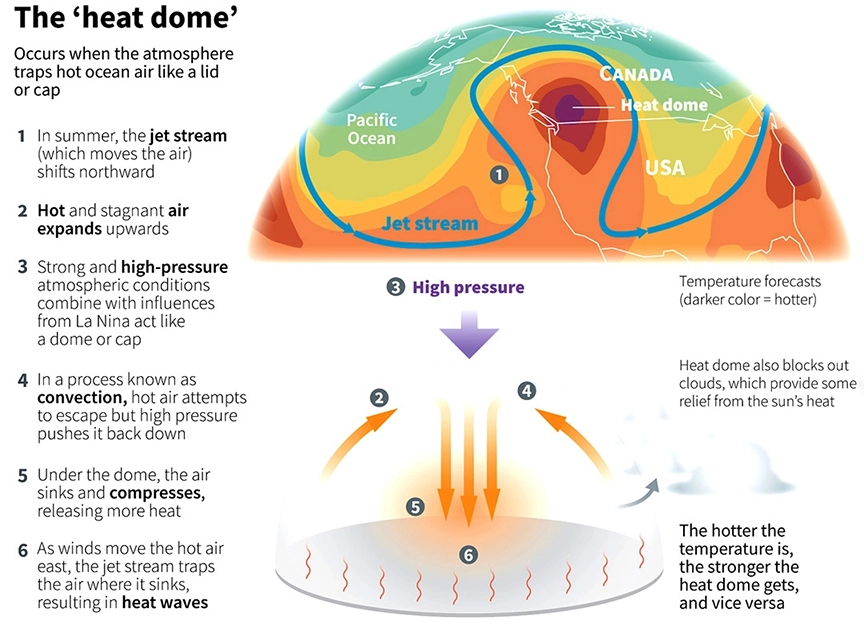-
29 Jul 2022
GS Paper 3
Disaster Management
Day 19: What is heat wave and heat dome? Describe its impacts and solutions. (250 Words)
- Define heat wave and heat dome.
- Discuss its impacts and solutions.
- Conclude suitably.
Answer
Heat Wave
A heat wave is a period of abnormally high temperatures, more than the normal maximum temperature that lasts for more than two days. Heat waves can occur with or without high humidity and have the potential to cover a large area, exposing a high number of people to hazardous heat. In the past few decades, heat waves have become larger, affecting 25% more land area in the Northern Hemisphere than they did in 1980. Including the ocean areas, heat waves have grown by 50%.
The Indian Meteorological Department (IMD) has given the following criteria for Heat Waves:
- Heat Wave need not be considered till maximum temperature of a station reaches at least 40°C for Plains and at least 30°C for Hilly regions.
- When normal maximum temperature of a station is less than or equal to 40°C Heat Wave Departure from normal is 5°C to 6°C Severe Heat Wave Departure from normal is 7°C or more.
- When normal maximum temperature of a station is more than 40°C Heat Wave Departure from normal is 4°C to 5°C Severe Heat Wave Departure from normal is 6°C or more.
- When the actual maximum temperature remains 45°C or more irrespective of normal maximum temperature, heat waves should be declared.
Heat Dome
A heat dome occurs when the atmosphere traps hot ocean air like a lid or cap. A heat dome is created when strong high-pressure atmospheric conditions combine with weather patterns like La Nina. They are more likely to form during La Nina years like 2021, when waters are cool in the eastern Pacific and warm in the western Pacific. creating vast areas of sweltering. According to NOAA, a heat dome typically lasts a week. The formation after a week becomes too big to keep standing and falls over, releasing the trapped air and ending the swelter.
Impact of Heat Waves and Heat Domes:
- Risk of Wildfires: The heat domes act as fuel to wildfires, which destroys a lot of land area every year in countries like the US.
- Prevents Cloud Formation: The condition also prevents clouds from forming, allowing for more radiation from the sun to hit the ground.
- Heat Strokes and Sudden Fatalities: The very high temperatures or humid conditions pose an elevated risk of heatstroke or heat exhaustion. Older people and people with chronic illness such as heart disease, respiratory disease, and diabetes are more susceptible to heatstroke. Houses without air conditioners experience an unbearable rise in temperature of their home which can lead to sudden deaths.
- Effect on Vegetation: The trapping of heat can also damage crops, dry out vegetation and result in droughts.
- Increased Energy Demands: The sweltering heat wave also leads to a rise in energy demand, especially electricity, leading to push-up rates.
- Power Related Issues: Heat waves are often high mortality disasters. Avoiding heat-related disasters depends on the resilience of the electrical grid, which can fail if electricity demand due to air conditioning use exceeds supply. As a result, there is a double risk of infrastructure failure and health impacts.
Steps for Avoiding Heat Waves:
- Individual Level:
- Staying Hydrated: Staying indoor and at rest in a very dry room with about 10% relative humidity, and drinking water constantly, can help avoid overheating at temperatures as high as 46°C.
- Altering Workout Routines: Exercising early in the morning when it is still cool or in air-conditioned indoor spaces.
- Public Level:
- Public Cooling Shelters: A number of emergency cooling shelters can be opened so that people without domestic air conditioning units can escape the heat. Air-conditioned rooms and buildings are the biggest help to people caught under a heat dome.
- Portable ACs: Portable air-conditioning units, along with fans and even ice is also useful.
- Long Term Solutions:
- Afforestation: Trees don’t just provide much-needed shade for a sweaty city. The water evaporating from their leaves can cool a neighborhood by a few degrees during the hottest periods. Tree leaves also absorb and filter local air pollution; heat waves can worsen urban smog, which may put comorbid at risk.
- Replacing Dark Roofs: A big reason that cities are so much hotter than rural areas as they are covered by dark roofs, roads and parking lots that absorb and retain heat. Replacing the dark surfaces with lighter more reflective materials will result in a comparatively cooler environment.
- Preparing for the Blackout: Smarter grids and new forecasting tools could help electric utilities prepare for heat waves. Using electronic controls to pre-cool buildings before temperatures peak in the daytime.
It is time now that concrete plans are put in place to deal with heat waves and closely linked extreme weather events. Early warning systems, heat-proof shelters and major afforestation are of vital need to reduce heat wave fatalities.






